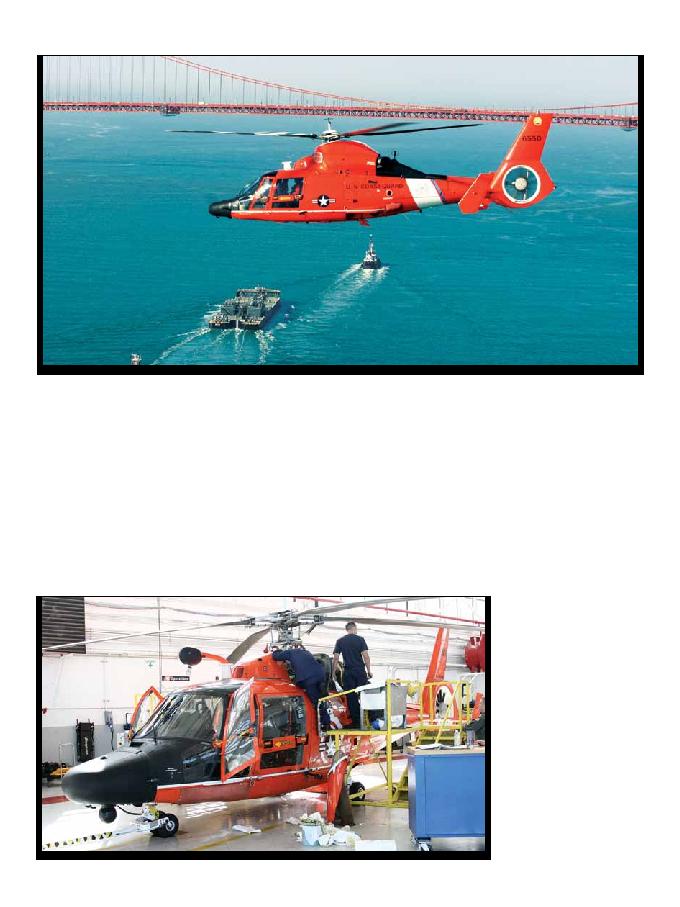
38
GA
/ Vol. 5 / No. 2 / FEBRUARY 2013
agustawestland.com
Challenging times require superior answers. AgustaWestland
comfort, performance and safety.
Maximise your time and be where it counts.
LEADING THE FUTURE
It's about your business
AgustaWestland: The benchmark for VIP helicopters in Africa
C
M
Y
CM
MY
CY
CMY
K
Global Aviator South africa AW139-GN VIP.pdf 1 06/08/12 15:56
responsible for supporting missions
throughout New York, New Jersey,
Pennsylvania, Delaware, Maryland,
Washington, D.C., and parts of Vir-
ginia. Air Station San Francisco were
expected to receive their upgraded
MH-65Ds before the end of 2012.
The Coast Guard is relying on new
student pilots to join the force as well
as former U.S. Army, U.S. Navy, U.S.
Air Force, and U.S Marine Corps
pilots to bring additional skills and
experience to the units. Approxi-
mately forty percent of current avia-
tors have a background in one of the
other branches of the U.S. military.
"For many of them, it is a culture
shock. However, bringing in these
experienced pilots helps keep us at a
higher level of skill," said CDR Brian
Glander, Air Station San Francisco's
Executive Officer. "The training of
new student pilots is conducted at the
Aviation Training Center in Mobile,
Alabama. It takes a lot of time before
we can deploy them to one of the
units.""Student pilots begin their
training at Naval Air Station Pensa-
cola, with pilots from other branches
of the U.S. military," explained
Culver. "We start with approximately
25 hours flying time in the Cessna.
Then we transition to the T-34/T-6 for
an additional one hundred hours of
flying. To complete the training, heli-
copter pilots transition to the TH-57
for nearly 125 hours. After complet-
ing the training successfully the new
pilots will transition to their assigned
unit to learn more about search and
rescue flights and working in a team,"
said Culver. New pilots assigned to
the unit will start with about four
to six familiarization flights. "We
learn how to conduct search and
rescue operations specific to our
area of responsibility," said LCDR
Harper Phillips, Operations Officer
at Air Station San Francisco. "The
majority of the flights we conduct are
training flights in order to prepare
ourselves for real-life action". Every
six months, each pilot has to pass a
number of qualifications for hoisting,
boat missions and operations utiliz-
ing night vision goggles.
Of the station's four MH-65Cs,
there is always one helicopter avail-
able for deployments aboard of one
of the Coast Guard's "cutters" a
term for a vessel longer than 65
feet. "Basically, we can do our op-
erations in the San Francisco Bay
area with three aircraft," explains
Philips. "One of our recent deploy-
ments to the Arctic region was to
oversee the oil drilling conducted
by Shell. Deployments like that one
clearly show how far we reach in
our missions." Besides search and
rescue and oversea deployments,
the station is also involved in a new
mission introduced in 2007, called
airborne the use of force. For this
purpose, the MH-65s are able to
carry both the M-14-T and M240H
machine guns to conduct missions.
CDR Glander was involved in the
introduction of this new type of
mission to the Coast Guard. "My
personal goal is to fully institu-
tionalize the new law enforcement
role in the business processes of
the unit, so it can be modeled as
a standardized template for other
Coast Guard units. We've come a
long way and we want to find the
best method of operating and train-
ing dedicated crew members for
new missions." ·
The MH-65 "Dolphin" has been in service since the 1980s. Over 100 of the type are currently in use. The unit at San Francisco will convert to the MH-65D as of November 2012.
Maintenance is vital to have the MH-65
operational at all times. Much work is
undertaken to avoid corrosion by sea
water. After each flight the MH-65s are
towed in the hangar for a check up.

